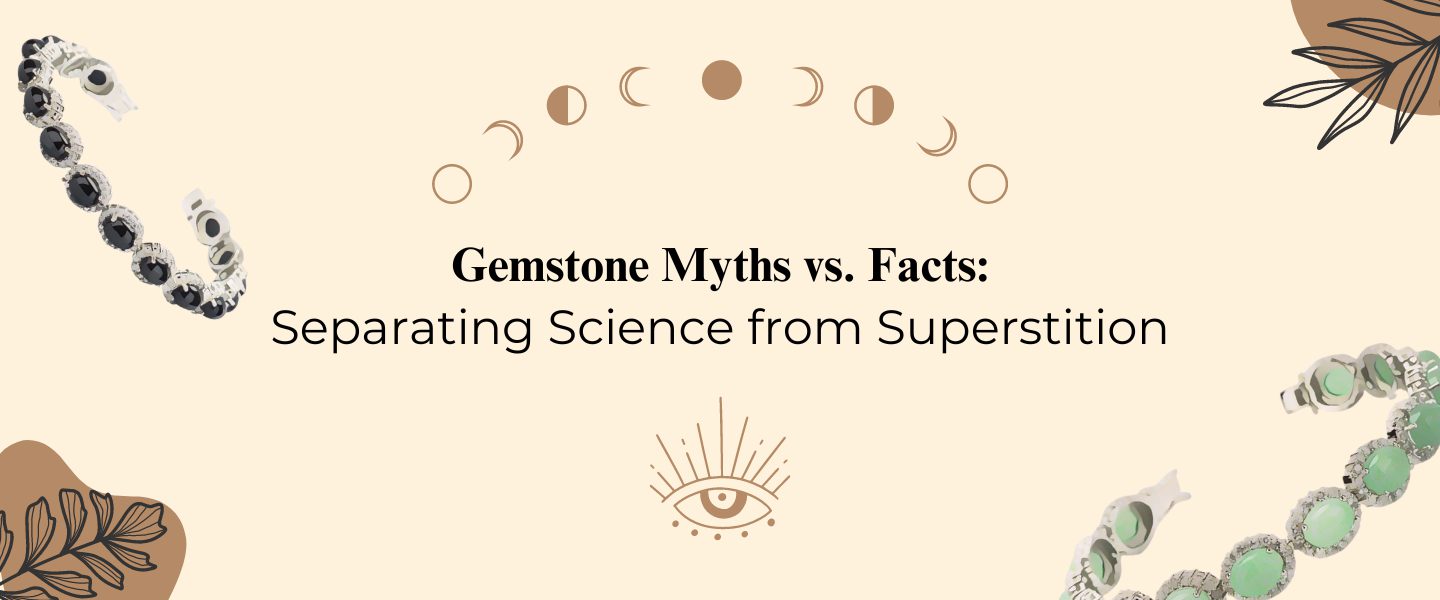Introduction
For centuries, gemstones have captivated the human imagination, not only for their beauty but also for the myriad myths and legends that surround them. These stones have been linked to superstitions, believed to possess magical properties, and even credited with influencing the fate of entire civilizations. But how much of what we believe about gemstones is rooted in fact, and how much is pure myth?
At Varnium by JMT, we are committed to celebrating the natural beauty and scientific marvels of semi-precious gemstones while also acknowledging the fascinating myths that have developed around them. In this blog, we’ll explore the world of gemstone myths and facts, helping you separate science from superstition.
The Origins of Gemstone Myths: A Journey Through History
To understand why gemstones are surrounded by so many myths, it’s important to explore their historical context. Throughout history, gemstones have been associated with various powers and meanings, often reflecting the cultural and religious beliefs of the time.
- Ancient Civilizations: The Birthplace of Gemstone Myths The origins of many gemstone myths can be traced back to ancient civilizations such as Egypt, Mesopotamia, and India. These cultures revered gemstones for their perceived connection to the divine and their supposed ability to protect the wearer from harm.
- For example, the Egyptians believed that the gemstone lapis lazuli had protective properties and could grant the wearer access to the gods. This belief was so strong that lapis lazuli was often included in the burial masks of pharaohs, ensuring their safe passage to the afterlife.
- Similarly, in India, gemstones have long been linked to astrology and spirituality. The concept of Navaratna, which involves wearing nine specific gemstones to align with the planets, reflects the deep belief in the metaphysical properties of these stones.
- While these beliefs are rooted in the cultural and religious practices of their time, they have contributed to the myths that continue to surround gemstones today.
- The Middle Ages: The Rise of Gemstone Superstitions During the Middle Ages, gemstones became increasingly associated with superstition and magic. Mediaeval Europeans believed that gemstones could cure illnesses, protect against evil, and even influence the outcome of battles. These beliefs were often based on the doctrine of signatures, which suggested that the physical appearance of a stone indicated its healing properties.
- For example, bloodstone, with its red flecks, was believed to have the power to stop bleeding and was often carried by soldiers in battle. Similarly, amethyst, with its purple hue, was thought to prevent drunkenness—a belief that dates back to ancient Greece but persisted into the mediaeval period.
- While these beliefs were widely held, they were often based on anecdotal evidence rather than scientific fact. As a result, many of the gemstone superstitions from this period have since been debunked.
Common Gemstone Myths: Unpacking the Legends
Gemstones have inspired countless myths over the centuries, many of which continue to influence how we perceive these stones today. Let’s take a closer look at some of the most common gemstone myths and separate fact from fiction.
- Myth 1: Diamonds Are Indestructible One of the most enduring myths about gemstones is that diamonds are indestructible. While it’s true that diamonds are the hardest naturally occurring substance on Earth, they are not indestructible. Diamonds can be chipped, cracked, or even shattered if struck with enough force or if they have internal flaws.
- Fact: The hardness of a diamond is measured on the Mohs scale, where it ranks at the top with a score of 10. This means that diamonds are highly resistant to scratching, but they are not immune to damage. Understanding the true nature of diamonds can help you care for them properly, ensuring they last a lifetime.
- Myth 2: Emeralds Can Cure Illnesses Emeralds have long been associated with healing properties, particularly in the realm of eye health. In ancient times, it was believed that emeralds could cure eye diseases and improve vision. This belief was so strong that some people would grind emeralds into powder and use it as a remedy.
- Fact: There is no scientific evidence to support the claim that emeralds can cure eye diseases or any other illnesses. While the vibrant green colour of emeralds may be soothing to the eyes, it’s important to rely on modern medicine for treating health conditions.
- Myth 3: Sapphires Protect Against Poison In mediaeval Europe, sapphires were believed to protect against poisoning. This myth likely arose because of the stone’s deep blue colour, which was associated with purity and divine protection. Royalty and nobility would often wear sapphires as a safeguard against being poisoned.
- Fact: While sapphires are beautiful and durable gemstones, there is no scientific basis for the belief that they can protect against poison. This myth is a reminder of the power of symbolism in history, but it should not be taken as fact.
- Myth 4: Opals Are Bad Luck One of the most pervasive myths about gemstones is that opals bring bad luck. This superstition dates back to the 19th century when Sir Walter Scott’s novel Anne of Geierstein depicted an opal as a cursed stone. The myth was further fueled by a misunderstanding of opals’ delicate nature, leading to the belief that they were ill-fated.
- Fact: Opals are no more likely to bring bad luck than any other gemstone. In fact, they are highly valued for their unique play of colour and are considered symbols of hope and creativity in many cultures. The notion of opals being unlucky is purely a superstition with no basis in fact.
- Myth 5: Pearls Dissolve in Vinegar Another popular myth is that pearls can dissolve in vinegar, a belief that stems from a famous story about Cleopatra dissolving a pearl in vinegar to win a bet. This myth has been passed down through generations, leading some to believe that pearls are extremely fragile.
- Fact: While it is true that the calcium carbonate in pearls can be dissolved by acetic acid, the process is not as instantaneous as the myth suggests. It would take a considerable amount of time for a pearl to fully dissolve in vinegar. However, pearls are delicate and should be handled with care, avoiding exposure to harsh chemicals.
The Science Behind Gemstones: Understanding Their True Nature
To debunk these myths, it’s essential to understand the science behind gemstones. Gemstones are minerals that have formed over millions of years through natural processes. Their beauty, colour, and properties are the result of complex geological conditions, and each stone has unique characteristics that can be scientifically explained.
- The Formation of Gemstones Gemstones are formed under specific conditions within the Earth’s crust. Factors such as temperature, pressure, and the presence of certain elements influence the formation of different gemstones. For example, the deep blue colour of sapphires is due to the presence of trace amounts of titanium and iron, while the green colour of emeralds comes from chromium or vanadium.
- Understanding the geological processes that create gemstones helps us appreciate their natural beauty without attributing mystical properties to them. Each gemstone is a product of millions of years of natural history, making it a true wonder of the Earth.
- The Physical Properties of Gemstones Gemstones are classified based on their physical and optical properties, including hardness, refractive index, and specific gravity. These properties determine a gemstone’s durability, brilliance, and how it interacts with light.
- The hardness of a gemstone, measured on the Mohs scale, indicates its resistance to scratching. Diamonds, for example, have a hardness of 10, making them highly resistant to scratches, while turquoise has a hardness of 5-6, making it more susceptible to damage.
- The refractive index of a gemstone measures how light bends as it passes through the stone. This property is responsible for the brilliance and sparkle of gemstones like diamonds and sapphires. Understanding these properties allows us to appreciate gemstones for their natural characteristics, rather than relying on myths.
- Gemstone Enhancements and Treatments Many gemstones undergo treatments to enhance their colour, clarity, or durability. These treatments can include heat treatment, irradiation, and oiling. While these enhancements are common in the gemstone industry, they do not alter the natural properties of the stones.
- It’s important for consumers to be aware of gemstone treatments, as they can affect the value and care of the stones. By understanding the science behind these treatments, we can make informed decisions when purchasing and caring for gemstone jewellery.
Debunking Superstitions: The Role of Education and Awareness
While gemstone myths can be entertaining, they can also lead to misconceptions and unrealistic expectations. Educating consumers about the true nature of gemstones is essential in promoting a better understanding of these natural wonders.
- The Importance of Gemological Education Gemology, the study of gemstones, plays a crucial role in debunking myths and promoting accurate information. Gemologists use scientific methods to study gemstones, identifying their properties, origins, and authenticity. By relying on gemological expertise, we can separate fact from fiction and appreciate gemstones for what they truly are.
- At Varnium by JMT, we believe in the importance of gemological education. By understanding the science behind gemstones, our customers can make informed decisions and appreciate the true value of their jewellery. We encourage everyone to learn more about the gemstones they wear, exploring their natural beauty without relying on superstitions.
- Promoting Ethical and Informed Choices The gemstone industry has made significant strides in promoting ethical practices and transparency. Consumers are increasingly interested in the origins of their gemstones, as well as the conditions under which they were mined. By choosing ethically sourced gemstones, consumers can support sustainable practices and ensure that their jewellery aligns with their values.
- Understanding the facts about gemstones also allows consumers to make informed choices about gemstone treatments and care. By debunking myths and promoting accurate information, we can create a more informed and responsible gemstone industry.
Conclusion: Embracing the Beauty of Gemstones Without the Myths
Gemstones have long been surrounded by myths and superstitions, but today, we have the knowledge and tools to separate science from fiction. While the myths can be fascinating, it’s important to appreciate gemstones for their natural beauty and scientific marvels.
At Varnium by JMT, we celebrate gemstones for what they truly are—wonders of nature that have formed over millions of years. Our jewellery is crafted with a deep appreciation for the natural properties of semi-precious gemstones, honouring their unique characteristics without relying on myths.
As you explore our collection, we invite you to learn more about the gemstones you wear. Embrace the science behind these stones and let go of the superstitions, appreciating the true beauty and value of your jewellery. At Varnium, we believe that knowledge is the key to a deeper connection with the gemstones you love.


